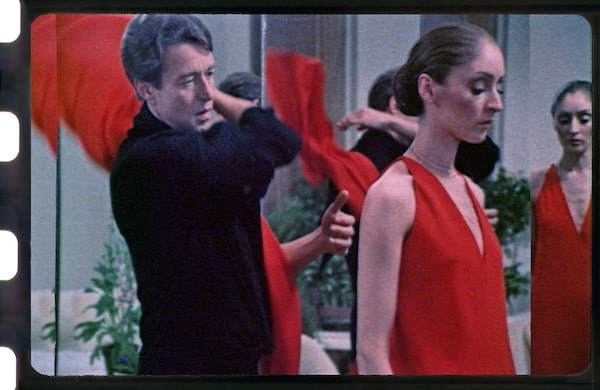
Halston, left, the late fashion designer, as seen in the documentary.The Orchard
- Documentary: Halston
- Directed by: Frédéric Tcheng
- Running time: 105 minutes
Halston was first a celebrity designer, as famous for his lifestyle as for his ingenious clothes. He got his first real taste of fame in 1961 after designing the trend-setting pillbox hat Jackie Kennedy wore to her husband’s presidential inauguration, and by publicizing his friends, his modernist townhouse, and his extravagant parties alongside his dresses. His talent lay as much in design as in canny self-promotion.
Charting Halston’s early career through to his death in 1990, at the age of 57, from AIDS-related cancer, Halston offers the usual biographical mix of news clippings, sketches and original interviews. Director Frédéric Tcheng (Diana Vreeland: The Eye Has to Travel, Dior & I) also brings in contact sheets and shows archive interview footage on a series of vintage TV monitors to reinforce the designer’s unparalleled genius in shaping his image.
Early in the documentary, for example, former millinery assistant Tom Fallon explains how he and Halston would often walk to work together. As they passed through the doors of New York’s tony department store Bergdorf Goodman to his hat salon, Fallon recalls that Halston’s whole demeanour would go from companionable to haughty – even his voice would change. Roy Halston Frowick, he remembers with italics hanging in the air, “would become Halston.”
The magnetic Halston’s reach and influence in the freewheeling Studio 54 disco era, both in culture and fashion, is vast, and the documentary can’t resist the urge to incorporate every last detail from his Wikipedia page (and from the history written by Halston’s niece, Lesley Frowick, also an executive producer on the film, cited in the credits as a “research book of note.”)
In being overly comprehensive, perhaps Halston is trying to be a corrective to a previous rambling and ill-informed documentary called Ultrasuede that squandered its access to designer intimates like Bob Colacello, André Leon Talley and Liza Minnelli. Many of those participants, including Minnelli, plus an exhaustive slew of models, corporate executives, even his former florist, also appear here.
Throughout, there’s also an unnecessary layer of narration and noir framing with scenes of a fictional young detective-archivist (Tavi Gevinson) and cheesy dramatic re-enactments asking, “Whatever happened to Halston?”
This is where the documentary seems to have two competing agendas. One emphasizes how Roy Halston Frowick of Des Moines, Iowa, became the influential, one-name-only American designer and household name Halston, and seeks to assert his genius and cement his legacy – neither of which, frankly, seemed in dispute.
Like Mrs. Kennedy’s refreshingly simple sculptural pillbox hat, Halston’s sleek cashmeres, minimally draped jersey and ingeniously cut chiffon reflected the attitude of a new era for women. As model Karen Bjornson remembers: “You were free, inside your clothes.” Model Pat Cleveland is even more succinct: “He took away the cage.”
The documentary’s scrapbook of visual materials is often thrilling, but especially in its early focus on the purity of line and attitude of his runway presentations, with their simple and luxurious vision of glamour. The technical virtuosity required to execute that fluid simplicity is aptly distilled by a fashion curator, who explains that the pattern diagram for one ingenious single-seam, bias-cut dress, “looks like a Cuisinart blade.”
The underlying, more interesting documentary here, however, is concerned with understanding the why. Why seek the spotlight? One answer: after having made masks for more than a hundred clients who were attending Truman Capote’s legendary 1966 Black and White Ball, the question of whether Halston himself attended as a guest comes up to offer a clue: “You and I could not hope to be anything more than trained … poodles,” Fallon recalls the designer saying of the high society/worker divide at the time.
Leading the jet set, he would walk in the front door from then on at the forefront of the modern phenomenon when both designer and model became recognizable public figures.
If Halston is a victim, it’s of his own Faustian pact with capitalism. Eventually, it was the fallout after an unapologetically ambitious licensing contract for a cheaper secondary line with J.C. Penney that brought about Halston’s career downfall. It precipitated a backlash from luxury retailers like Bergdorf’s, who dropped his designer collections; clashing with his corporate owners and under pressure, the designer’s already demanding nature turned more tyrannical and toxic before finally, in 1984, being forced out of the company that bore his name.
“I have a theory that less becomes more,” Halston purrs in one early interview. The opposite may well be true, and the same could be said for this documentary.
Live your best. We have a daily Life & Arts newsletter, providing you with our latest stories on health, travel, food and culture. Sign up today.